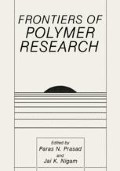Abstract
Copying and duplicating machines are based on xerography1 in which electrostatic images produced in a photoconductive film are developed into visible images by charged pigment particles. The seven steps of xerography (Fig. 1) are: (1) corona charging the photoconductor film, called a photoreceptor; (2) forming an electrostatic image on the photoreceptor by exposing with light; (3) developing the image by charged pigment particles called toners; (4) transferring the toner image onto the paper; (5) fixing the image onto the paper; (6) cleaning the photoreceptor of residual toner; and (7) erasing the remaining electrostatic image by uniform illumination.
Access this chapter
Tax calculation will be finalised at checkout
Purchases are for personal use only
Preview
Unable to display preview. Download preview PDF.
References
C. Carlson, “History of Electrostatic Recording,” in: “Xerography and Related Processes,” J. H. Dessauer and H. E. Clark, eds., Focal Press (1965).
M. E. Scharfe and F. W. Schmidlin,“Charged Pigment Xerography,” in: “Advances in Electronics and Electron Physics,” Academic Press (1975).
R. M. Schaffert, “Electrophotography,” Focal Press, London (1975).
J. W. Weigl, “Interfaces in Electrophotography,” in: “Colloids and Surfaces in Reprographie Technology,” M. Hair and M. D. Groucher, eds., American Chemical Society, Washington, D. C. (1982).
J. M. O’Reilly and P. F. Erhardt, “Physicl Properties of Toner Polymers,” in: “2nd International Conference on Electrophotography,” Washington, D. C. (1974).
P. C. Julien, “Triboelectrification of Carbon-Polymer Composites,” in “Carbon Black Polymer Composites,” E. K. Sichel, ed., Marcel Dekker, New York and Basel (1982).
J. Lowell and A. C. Rose-Innes, “Contact Electrification,” Adv. Phys., 29: 947 (1980).
D. A. Seanor, “Electrical Properties of Polymers,” K. Frisch and A. V. Patsis, eds., Technomic Press, New York (1972).
W. R. Harper, “Contact and Frictional Electrification,” Oxford University Press, Oxford (1967).
H. W. Gibson, “Linear Free Energy Relationships. V. Triboelectric Charging of Organic Solids,” J. Am. Chem. Soc., 97: 3832 (1975).
M. E. Scharfe, D. M. Pai and R. J. Gruber, “Electrophotography,” in: “Imaging Processes and Materials, Neblette’s Eighth Edition,” J. Sturge, V. Walworth and A. Shepp, eds., Van Nostrand Reinhold, New York (1989).
M. Stolka and D. M. Pai, “Polymers with Photoconductive Properties,” in: “Advances in Polymer Science, Vol. 29, ” H. J. Cantow et al. eds., Springer-Verlag, Berlin (1978).
D. M. Pai, “Transient Photoconductivity in Poly(N-vinyl carbazole),” J. Chem. Phys., 52: 2285 (1970).
J. Mort, G. Pfister and S. Grammatica, “Charge Transport and Photogeneration in Molecularly-Doped Polymers,” Solid State Commun., 18: 693 (1966).
G. Schlosser, “A New Organic Double Layer System and its Photoconduction Mechanism,” J. Appl. Photo. Eng., 4: 118 (1978).
P. J. Melz, et al., “Use of Pyrazoline Based Carrier Transport Layers in Layered Photoconductivity Systems in Electrophotography,” Photo. Sci. and Eng., 21: 73 (1977).
E. S. Baltazzi, J. Appl. Photogr. Eng., 6: 14 (1980).
M. Stolka, J. F. Yanus and D. M. Pai, “Hole Transport in Solid Solutions of a Diamine in Polycarbonate,” J. Phys. Chem., 88: 4707 (1984).
W. D. Gill, “Electron Mobilities in Disordered and Crystalline Trinitrofluorenone,” in: “Proceedings of the 5th International Conference on Amorphous and Liquid Semiconductors,” J. Stuke and W. Brenig, eds., Taylor and Francis, London (1974).
D. M. Pai and J. Yanus, “Layered Photoconductors in Electrophotography,” Photo. Sci. and Eng., 27: 14 (1983).
D. M. Pai et al., “Hole Transport in Solid Solutions of Substituted Triarylmethanes in Bisphenol-A-Polycarbonate,” Phil. Mag., 48: 505 (1983).
W. W. Limburg, D. M. Pai, J. F. Yanus, D. S. Renfer and P. DeFeo, “Designer Polymers for Xerographic Applications,” Fifth International Congress on Advances in Non-Import Printing Technologies, SPSE, San Diego, CA, Nov. 12–17 (1989).
M. A. Abkowitz, M. J. Rice and M. Stolka, “Electronic Transport in Silicon Backbone Polymers,” Phil. Mag., 61: 25 (1990).
Author information
Authors and Affiliations
Editor information
Editors and Affiliations
Rights and permissions
Copyright information
© 1991 Springer Science+Business Media New York
About this chapter
Cite this chapter
Pai, D.M. (1991). Polymers and Doped Polymers for Applications in Electrophotography. In: Prasad, P.N., Nigam, J.K. (eds) Frontiers of Polymer Research. Springer, Boston, MA. https://doi.org/10.1007/978-1-4615-3856-1_32
Download citation
DOI: https://doi.org/10.1007/978-1-4615-3856-1_32
Publisher Name: Springer, Boston, MA
Print ISBN: 978-1-4613-6721-5
Online ISBN: 978-1-4615-3856-1
eBook Packages: Springer Book Archive

